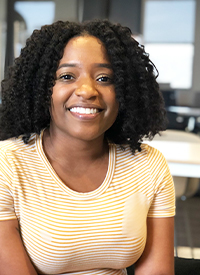By Tashi Copeland
Communications Manager
Millennials. Once upon a time, this generation was synonymous with “lazy” and “self-centered.” Little did society realize that these young people would be a generation of change- makers, not only wanting to transform the world that affects them directly, but also slip on the shoes of individuals from other walks of life. And as these young folks continue to navigate the world of adulthood, they’re becoming power players of the business community. Millennials are the largest population in the workforce, a statistic that isn’t going to diminish anytime soon. In addition to being able to edit a PDF or manage a social media platform, this generation also brings a new definition and appreciation of diversity and inclusion.
makers, not only wanting to transform the world that affects them directly, but also slip on the shoes of individuals from other walks of life. And as these young folks continue to navigate the world of adulthood, they’re becoming power players of the business community. Millennials are the largest population in the workforce, a statistic that isn’t going to diminish anytime soon. In addition to being able to edit a PDF or manage a social media platform, this generation also brings a new definition and appreciation of diversity and inclusion.
If you look to our country’s history, the idea of diversity and inclusion in the workplace has evolved with each generation. For the baby-boom generation, the idea of diversity in the workplace was a fairly new concept. It was intertwined with reputation and legality. Generation X yielded a more progressive workforce, with diversity being attached to numbers. This meant making sure the figures showed that companies indeed had all the boxes checked for varying genders and ethnicities. If you pitch these same definitions to a 90s kid, you’ll be sure to be hit with the 1995 cult classic film, Clueless’ famous line — “ugh, as if.”
Diversity and inclusion within the workplace will not be an added bonus, but an expectation.
For the modern-day millennial, diversity AND inclusion is essential to attracting talent. And with the job-jumping millennial averaging only two years of tenure at a company, it’s critical for companies to keep this in mind for employee retainment. As Indianapolis and its surrounding communities continue to grow into a power–player for attracting new talent and retaining the talent already here, Circle City companies must continue their pursuit in true diversity and inclusion. But what does that really mean?
Diversity and inclusion must be two separate concepts that work in tandem to enhance an organization. Diversity is not only the physical differences like race and gender, but also differing personality types and educational backgrounds. Once diversity is reflected in an organization, the idea of inclusion must come into play. Inclusion means empowering all individuals of the company’s diverse ecosystem to use their voice, as well as offering a seat at the table. It goes beyond obligation. It’s real encouragement and celebration of different thought perspectives.
Recently, I transitioned back to world of philanthropy—during a pandemic and an economic downturn, nonetheless. I joined the team at Central Indiana Community Foundation (CICF). In recent years, the foundation sharpened its focus to addressing racial equity in Central Indiana. CICF calls for a more inclusive city by helping to create environments and neighborhoods that are more equitable and dismantling the systems preventing people from the opportunity of reaching their full potential—no matter race, place, or gender.
CICF isn’t only looking outwardly at the community to complete this mission; the foundation is also looking in its own backyard. My role as a communications manager is positioned under the operations department. Prior to my arrival, the department had no person of color. Upon my appointment, leadership made me well aware of the fact that I was not just there to “tick off the box” for a Black employee category on the team. My differences aren’t merely a means to fulfill a societal requirement, but a true asset to the overall values, vision and work of the foundation. My experiences matter. My culture matters. My voice matters.
Conversations such as these will continue to matter to prospective applicants. As Generation Z—individuals born near the turning of the 21st century—begin to become of age, diversity and inclusion within the workplace will not be an added bonus, but an expectation. Zoomers are the first generation to have spent their whole lives during the digital age. As a result, they are the most global in their thinking and interactions. Keeping this in mind, they expect their employers to match the outside world.
Indianapolis is making strides to become a more inclusive city. Multiple equity initiatives and funds have been created to combat systemic issues that have impeded the progress of a more diverse and inclusive Indiana. Written, actionable commitments from major corporations with large footprints in the city like Eli Lilly and Salesforce—in addition to CICF— provide pathways for other organizations to approach this work.
True diversity and inclusivity for our community won’t happen overnight. It will take a joint effort across the state. If Indianapolis continues on its current path, more millennials will flock to the Circle City to spread their wings—and those already here—will take root and call this place home.






Leave A Comment